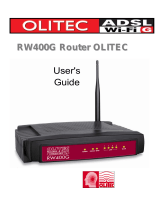
IV
4.6.5 Wireless Statistics ...................................................................................................34
4.7 DHCP..................................................................................................................................35
4.7.1 DHCP Settings ........................................................................................................35
4.7.2 DHCP
Clients Lis
t....................................................................................................36
4.7.3 Address Reservation...............................................................................................37
4.8 Forwarding ..........................................................................................................................38
4.8.1 V
irtual Servers.........................................................................................................38
4.8.2 Port Tr
iggering.........................................................................................................40
4.8.3 DMZ.........................................................................................................................42
4.8.4 UPnP
.......................................................................................................................42
4.9 Sec
urity ...............................................................................................................................43
4.9.1 Firewall....................................................................................................................43
4.9.2 IP
Filtering ...............................................................................................................44
4.9.3 Domain Filtering ......................................................................................................47
4.9.4 MAC
Filtering...........................................................................................................49
4.10 S
tatic Routing......................................................................................................................50
4.1
1 Dynamic DNS .....................................................................................................................52
4.12 System Tools.......................................................................................................................53
4.12.1 Time Setting
............................................................................................................53
4.12.2 Firmware
.................................................................................................................54
4.12.3 Factory Default
s
......................................................................................................55
4.12.4 Backup & Restore ...................................................................................................55
4.12.5 Reboot.....................................................................................................................56
4.12.6 Password.................................................................................................................56
4.12.7 System log...............................................................................................................57
4.12.8 Remote Management..............................................................................................58
4.12.9 Statistics ..................................................................................................................58
Appendix A: F
A
Q....................................................................................................................................60
Appendix B: Configuring the PCs ........................................................................................................65
Appendix C: S
pecifications.....................................................................................................
..............69
Appendix D: Glossary...........................................................................................................
.................70























